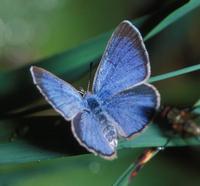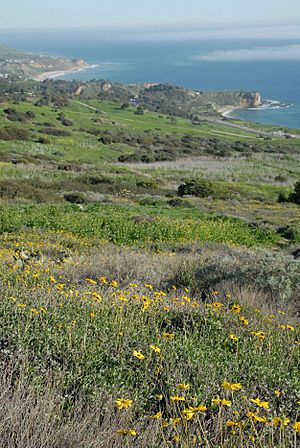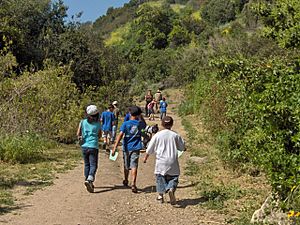Palos Verdes Peninsula Land Conservancy facts for kids
The Palos Verdes Peninsula Land Conservancy (PVPLC) is a special group that works to protect nature. It's a non-profit organization, which means it doesn't try to make money. Instead, it focuses on a very important job: "Preserving land and restoring habitat for the education and enjoyment of all."
This group is based on the Palos Verdes Peninsula in Los Angeles County, California. They act as a land trust and an environmental organization. Their main goal is to keep natural areas safe in the Palos Verdes Hills and along the coast. They protect different types of land, like California chaparral and woodlands, Coastal sage scrub, and Southern coastal grasslands.
Contents
Natural Preserves on the Peninsula
The Conservancy started in 1988. Since then, they have protected about 1,600 acres (6.5 square kilometers) of open land. This land is now beautiful nature preserves on the Palos Verdes Peninsula.
White Point Nature Preserve
The White Point Nature Preserve is in San Pedro, Los Angeles. It has 102 acres (0.4 square kilometers) of land where they have brought back the coastal sage scrub habitat. You can find hiking trails here, even some that are easy for people with disabilities. There's also a Nature Education Center with amazing views of the ocean and Santa Catalina Island.
Defense Fuel Supply Point: Home to a Rare Butterfly

The Defense Fuel Supply Point in San Pedro stores fuel for the military. But it's also a very important home for an endangered insect: the Palos Verdes blue butterfly. This tiny butterfly is sometimes called the "rarest butterfly on Earth"! Even with pipelines and storage tanks, this area provides a safe place for the butterfly and another threatened animal, the California gnatcatcher. The gnatcatcher is a small gray bird listed as threatened by the U.S. Fish and Wildlife Service.
Linden H. Chandler Preserve
The Linden H. Chandler Preserve is a 28.5-acre (11,530 square meter) area in Rolling Hills Estates. The city and the Conservancy own it together. They have worked hard to restore the habitat here, adding native wildflowers and shrubs. You can walk on trails through the hills and grasslands, and there's even a recently restored wetland area. This preserve was created in 1993 to honor Linden H. Chandler, who founded a local sand and gravel company.
Palos Verdes Nature Preserve: The Largest Area
The Palos Verdes Nature Preserve is the biggest area the Conservancy protects. It covers about 1,400 acres (5.7 square kilometers) of rolling hills, deep canyons, and rocky areas. It has natural habitats and stunning views of the Pacific Ocean and Santa Catalina Island. The city of Rancho Palos Verdes owns most of this land, and the Conservancy helps manage it. This large preserve is made up of 10 smaller reserves, including Abalone Cove, Portuguese Bend, and Filiorum Reserve.
Lunada Canyon Reserve
The Lunada Canyon Reserve is a 20-acre (8,094 square meter) canyon. It was given to the Conservancy in 1992 by the E.K. Zuckerman family. This canyon is an important part of the larger Palos Verdes Nature Preserve.
George F Canyon Preserve and Nature Center
The George F Canyon Preserve and Nature Center is 51 acres (206,390 square meters) big. The city of Rolling Hills Estates owns it, and the Conservancy runs it. A nature trail goes through one of the biggest canyons on the Palos Verdes Peninsula. You can walk or ride horses through areas with willow trees and coastal sage scrub. The trail ends with a view of the Los Angeles Basin.
The George F Canyon Nature Center offers fun educational programs. They invite everyone to visit and learn about the canyon. They have different exhibits that change often, so you might see something new each time! These exhibits teach about butterflies, birds, insects, plants, and wildflowers.
Science and Learning for a Better Future
The Conservancy works hard to fix damage to the land caused by cities, farms, and new plants that don't belong here. Their science program aims to learn more about the Palos Verdes Peninsula. They want to understand how the local ecosystem works. They do research with their own staff and also team up with universities and local groups.
Their research helps them plan how to restore nature, protect land, and teach others. It also helps them understand how nature and city areas can exist together.
Working with Local Groups
The Conservancy partners with many local groups. They have worked with Eagle Scouts, Girl Scouts, and other community groups. These projects help young people earn awards while also helping the local environment. The Conservancy also works with high schools, colleges, and universities on science and geography projects.
Youth Education Program
The Conservancy has special programs for students in local schools. These programs help many young people learn about nature. Their Youth Education programs include nature walks for third graders and projects with high school science classes and scout groups. Through these programs, the Conservancy helps young students understand how important the natural areas of the Palos Verdes Peninsula are. This helps them feel like they can play a part in protecting it.
Third-Grade Naturalist Program
The Naturalist program for third graders has four parts. It's taught in the classroom and covers local nature, native plants, geology, history, Native-American culture, mammals, reptiles, and insects. Teachers from the Conservancy and trained volunteers lead these lessons. They use real plant samples, rocks, and animal specimens. This helps students learn with their hands and truly appreciate nature.
Fun Activities and Ways to Help
Palos Verdes Pastoral Dinner
Every fall, the Conservancy hosts a special dinner called Palos Verdes Pastoral. It's held outdoors with beautiful ocean views. Over 200 guests attend each year. This event helps raise important money for the Conservancy. It also shows how important the community is in protecting natural areas.
Nature Walks for Everyone
On the second Saturday of every month, the Conservancy leads a free nature walk. They explore one of their many preserves. The walk leaders help visitors learn about the birds, wildlife, and plants that live in the canyons. They also teach about the unique geology of the Peninsula. These walks are a great way to explore and learn!




